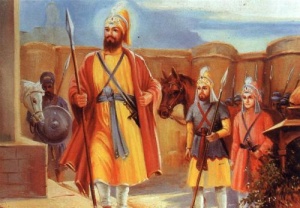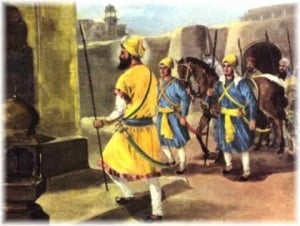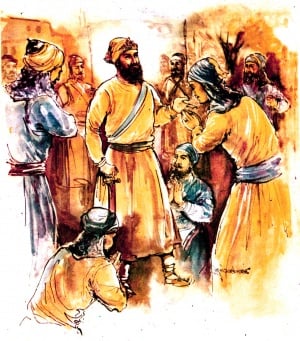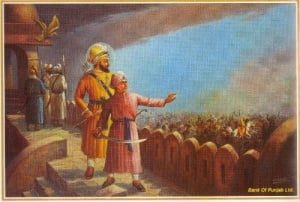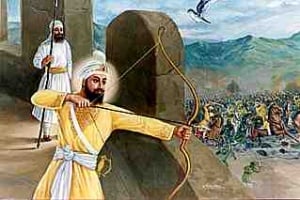Second battle of Chamkaur Sahib
A Story of Bravery and Sacrifice
| Second Batlle of Chamkaur | |
|---|---|
| Date: December 20 - 23 1704[1]
(according to Giani Gian Singh Panth Parkash) 1705[2][3] (according to Bansavalinama Dasan Patshahian Kesar Singh Chibbar and Pracheen Panth Prakash by Rattan Singh Bhangu ) | |
| Result: Mughal Victory but they fail to capture Guru Gobind Singh ji[1][2][3][4] | |
| Belligerents | |
| Khalsa[1][2][3][4] | Mughal Empire |
| Commanders | |
| Guru Gobind Singh
Bhai Daya Singh Bhai Dharam Singh Bhai Himmit Singh (KIA) Bhai Mokham Singh (KIA) Bhai Sahib Singh (KIA) Baba Ajit Singh (KIA) |
Aurangzeb
Wazir Khan(Sirhind) Zabardast Khan Khwaja Muhammad (WIA) Nahar Khan (KIA) Mu'nim Khan Ghairat Khan (KIA) |
| Strength | |
| 40 - 45 (Sources Vary) | 1,000,000 (Few sources say 700,000) |
| Cassulties | |
| 38 - 42 (Sources Vary) | Unknown but much greater then the Sikh Casualties |
The Battle of Chamkaur, also known as the Second battle of Chamkaur was a battle fought between the Khalsa, led by Guru Gobind Singh, against the Mughal army and Ajmer Chand's league of Rajput Hill Chieftains. The period of this Battle in Chamkaur is 21,22 and 23 December 1704 [6,7,8 Poh Samat 1761 Bikrmi]. Guru Gobind Singh with his entourage left Anandpur Sahib at the night of 20 December 1704.
Guru Gobind Singh makes a reference to this battle in the Zafarnamah. He tells how a huge (Dahlakh) army [5][6] attacked his Sikhs who were only forty in number and without food. In spite of their numerical strength, the Mughal soldiers were unable to kill or capture the Guru. The Guru also talks of cowardice of one of the Mughal generals and how he hid himself behind a wall, not having the courage to face the Guru.
Background
Under the pressure of a prolonged siege with food and ammunition exhausted, Guru Gobind Singh and 400 Sikhs left Sri Anandpur Sahib on the bitter cold and rainy night of December 20, 1704. The Mughals and Ajmer Chand's league of Rajput Hill Chieftains had offered Guru Sahib a safe passage to leave Anandpur Sahib on an oath sworn on the Quran, an oath that had been signed by emperor Aurangzeb, as well as, an oath swore on the cow (which Hindus consider sacred) by the Rajput Chieftains. However, their respective 'Holy' oaths proved to be meaningless as they lost little time betraying their promises to Guru Sahib, almost as soon as the Sikhs had left the safety of their impregnable fortress.
Maharaj writes in the Zafarnama:
| 13: Aurangzeb! I have no trust in your oaths anymore. (You have written that) God is one and that He is witness (between us). 14: I don’t have trust equivalent to even a drop (of water) in your generals (who came to me with oaths on Koran that |
In the early hours of the [intervening night of 20,21,December 1704] at the rivulet Sarsa, at a distance of about 25KM from Anandpur Sahib, the Guru and his Sikhs were attacked by the Mughal army, breaking their oath of assuring safe conduct. In the confusion, which followed the attack in the cold and darkness, many Sikhs became Shaheed (martyrs).
A group of Singhs fought the armies, keeping them back while the rest of the Sikhs, Guru Sahib and Guru Sahib's family crossed the rivulet in the heat of the battle. Many Sikhs perished attempting to cross the frigid waters of the turgid, rain swollen rivulet. Their bodies ware swept away by the swift current. During the confusion, the Guru's mother and his two youngest sons, Guru's Mahil got separated from the Khalsa forces. Of the 400 hundred that had left Anandpur, only the Guru, his two eldest sons, the [Panj Piaras] ( Five Beloved ones) and 40 Sikhs were able to cross the river and regroup on the other side.
Gurdwara Parivar Vichora has been built on the spot of the battle, during which the Guru's mother and his two youngest sons got separated from the band of Sikhs.
Chamkaur Sahib
On 21 December 1704, Guru Sahib, Panj piaras and 40 Singhs camped in an open space in Chamkaur. In the evening Guru with his sikhs took control of Kachi Garhi a Mud fortress on a small hill. Kachi Garhi was owned by two brothers Chaudhari Roop Chand and Jagat Singh. They offered their services to Guru. Guru Sahib had visited Chamkaur in 1702 while returning from Kurekshetra. Guru Sahib and 40 Singhs moved into the house of Chaudhari Roop Chand and Jagat Singh situated on a hill. The Haveli with its high paraimeter mud brick wall now became the fort of Guru Sahib.
At the commencement of Amritvela (early hours of the day before sunrise) Guru Sahib woke up Bhai Sangat Singh.
"Wake up Sangat Singh, its time for Asa di Var. Let's do Kirtan," Guru ji said.
What an amazing warrior-saint Guru was! An army of around 1 Million was pursuing Guru Sahib and planning to attack the place where they were staying, and yet Guru Sahib was still blissfully continuing his daily discipline of meditation, Nitnem and Kirtan, with his Singhs.
Mugal generals, yelled over the wall, "Gobind Singh! If you and your Sikhs come out now, you will be spared!" Guru Sahib replied to this with a rain of arrows. There was silence now in the cold morning. Clouds filled the sky followed by thunder and lightening. Guru and the Singhs became ready for the battle.
Preparing for Battle
In the chilly hours before sunrise a Mughal messenger came to negotiate with the Sikhs. However, Guru Sahib told the messenger to go away or face death. Inside the four walls of the mud-house Guru Sahib declared war.
First one Singh came out and when he was about to become Shaheed (martyr), he roared the Jaikara (slogan) of "Sat Sri Akal!" As soon as the sound of "Sat Siri Akal" echoed throughout the battlefield, the next Singh came out to fight in the battleground. The Nawab was astonished at what these Singhs were made of. He remembered the sayings of the Sikhs that "One Sikh equalled Sava Lakh (125,000)" – the bravery of one Sikh is equal to that of 125,000 ordinary men.
Baba Ajit Singh enters the battlefield
With Guru ji's blessings, six of the Sikhs, Muhar Singh, Kirat Singh, Anand Singh, Lal Singh, Kesar Singh and Amolak Singh went forth to show their worth. Despite the overwhelming odds the Sikhs inflicted tremendous losses on the Mughals but eventually one by one they were fatally wounded and departed to join Waheguru.
Baba Ajit Singh then went before Guru Sahib and said, "Pita ji (dear father), permit me to go and fight on the battleground and grace me with the opportunity to make my life fruitful and worthy in service of the panth."
Guru Gobind Singh hugged his beloved son and gave him a Shastr (weapon). Little of a beard or moustache had yet appeared on Baba Ajit Singh 's face, showing how young he was. Every father wants to see his child get married, but this was the time of fighting the enemy and defending the path of righteousness. But, that day death was waiting and Baba Ajit Singh would be marrying death.
The sun was about to rise. Guru saw Mughal generals intending to seize the fort of Chamkaur in one attempt. The Mughal Generals surrounded the fort with their army. At this time the Singhs made a benti (request) to Guru Sahib that since there was no means of escaping the siege, he should escape with the Sahibzade. However Guru Sahib told them that there is no difference between the Singhs and the Sahibzade. "You are all my sons! We will be victorious and we will all be free."
Baba Ajit Singh boldly and valiantly came out of fort, accompanied with 5 other Singhs, which included one of the original Panj Piarey, Bhai Mohkam Singh. Guru watched the battle scene from the top of the fort. There was silence on all four sides. As they came into the battleground they roared, "Jaikarey", which sounded like the roar of a lion. Today the 5 Singhs felt proud that under the leadership of Baba Ajit Singh , they had been blessed with an opportunity to fight on the side of the truth and the correct path of Guru Nanak. Baba Ajit Singh with the five Sikhs advanced swiftly onto the battlefield displaying his great courage, bravery and skills with weapons.
The enemy was immediately repulsed and many of the soldiers of thetreacherously deceitful Mughal and Hill forces met their deaths. Such was the fury of the Sikh contingent and the dedicated, continuous and precise support from the haveli-fortress that this small Sikh party of 6 bahadurs (brave men) of the Khalsa eliminated hundreds of brave enemy soldiers.
The enemy in one section was completely paralysed and disabled by the enormous strength and sudden impact of the Khalsa unit. With protection fire from the fort, which kept the surrounding army units in check and blocked their involvement in the battle on the ground.
After killing many hundreds of the enemy, the group began to take casualties. Slowly the impact of the unit began to diminished and after almost an hour, the enemy began surrounding the Sahibzada from all four sides.
Baba Ajit Singh called out, "Come nearer if you have courage." The soldiers ran away frightened. Slowly, they began coming back in a larger group as not a single one of them had the courage to individually fight Baba Ajit Singh ji.
The Singhs' weaponry skill on the battlefield reminded the Mughal soldiers of Ali their fabled warrior, and they feared for their lives. While fighting, Baba Ajit Singh's kirpan (sword) broke. He then began to fight with a Neja (spear).
However, while killing one Mughal chief, it became stuck in his chest. Even then, Baba Ajit Singh remained in bliss and peace. While fighting, however, one by one the 5 Singhs were overcome and lost their life and became Shaheed (martyrs) of the Guru. One Mughal chief injured Baba's horse.
As a result, Baba ji fought from the ground with his talwar (sword). With each blow of his sword, he split the enemy into two. When he struck the enemy twice with his sword, they got cut up into four pieces. Now as the army surrounded the sahibzada, Guru watched with keen interest to see how bravely his son would live his last few minutes of life.
When Baba attained Shaheedi, Guru Sahib roared a Jaikara of "Sat Siri Akal" full of emotions and courage - a salutation to the Almighty for the blessing of such a brave and noble son.
Baba Jujhar Singh also ready
The news of Baba Ajit Singh attaining Shaheedi (martyrdom) spread. Hearing the news of his brother, Baba Jujhar Singh now desired to fight in the battlefield.
He asked Guru Sahib, "Permit me, dear father, to go where my brother has gone. Don't say that I am too young. I am your son. I am a Singh, a Lion, of yours. I shall prove worthy of you. I shall die fighting, with my face towards the enemy, with the Naam on my lips and the Guru in my heart."
Guru Gobind Singh embraced him and said, "Go my son and wed the life-giving bride, Death. May the Almighty be with you always"
Guru Sahib gave blessings to Baba Jujhar Singh just like a father gives blessings to the bride on the day of her marriage. Guru added, "I asked my father to give his life for "dharam" (righteousness and justice). Today, what I told my father, I now tell you son."
Bhai Himmat Singh and Bhai Sahib Singh (two of the original Panj Piarey) along with 3 other Singhs accompanied Sahibzada Baba Jujhar Singh . The Mughals were shocked at what they saw. To the enemy, it looked as if Ajit Singh had come back.
"Whoever dies, let him die such a death, that he does not have to die again. (1)" (Ang 555, SGGS)
Dead bodies lay everywhere. Baba Jujhar Singh chose to attack another section of the enemy. He had observed the enemy and chose to attack the section who were showing more aggression against the Sikhs in the mud-fort then the rest of the enemy. Initially, the enemy did not have any courage to formulate an attack against this second unit after the fury of the force displayed by Ajit Singh's unit.
To them this appeared like a repeat of the same disaster that had befallen them an hour or two ago. They had not even had time to recover from the previous shock and now they had a second wave of the same enormously vibrant energy. This time the enemy was driven even further back; many just took flight as they thought that the Sikh numbers must have increased and so many of the enemy deserted the battlefield. This new force of six Khalsa soldiers killed many hundreds of the enemy; many simply ran away.
The enemy were stunned by the heavy force and thrust of this second attack and had little choice but to retreat back. The Khalsa unit created a huge void in the enemy territory and a small circle of about 35 metres within the enemy ground was under the control of the Sikhs. No one had the courage to enter into this circle of control. Anyone who entered this area of command was immediately challenged and quickly extinguished. The Khalsa unit, with their backs to the centre of this circular area attacked the enemy courageously and with vigour at the perimeter of the controlled region.
The Guru watched this development with pride and gratefulness to the Almighty and he knew that the Sikhs had learned the lessons of warfare well and would soon join the many hundreds of Sikh martyrs who had attained the highest honour of Dharam. The Almighty had indeed blessed the Sahibzade and the Sikhs with true bravery and deepest understanding of the Guru's message.
Slowly, due to the huge number of the enemy, they eventually assembled around Baba Jujhar Singh. He was now surrounded and had a Neja (spear) in his hand. Wherever the Neja hit, the enemy was destroyed. He also used a Khanda (double-sword), with which he killed the enemy as a farmer mows down his crop. Guru saw that Jujhar Singh was being surrounded and the opportunity to kill the Mughal soldiers was decreasing. For over 2 hours the Khalsa unit had continued to desolated the enemy. They were becoming tired.
So Guru Sahib fired volleys of arrows in the area around the Sahibzada's unit giving 'protection fire' to the Sikh soldiers. The person providing protection fire must be very skilful and precise because if the target is missed, people on the same side can be killed giving rise to 'casualty from friendly fire'. Guru sahib continued to give protection cover with arrows for almost 30 minutes, but none of the 5 Singhs or Baba were hit or injured by the arrows. Baba ji and the 5 Singhs demonstrated the Sikh concept of one equalling the bravery and courage of "Sava Lakh" (125,000) humans.
Baba Jujhar Singh eventually was able to break the ring of the Mughal army soldiers surrounding him. However, due to the huge number of enemy soldiers, Baba eventually attained Shaheedi but died a hero's death in the fight against tyranny and falsehood.
"That person alone is known as a spiritual warrior, who fights in defence of religion. They may be cut apart, piece by piece, but they never leave the field of battle. 22." (Ang 1105, SGGS)
This was truly a sign of a dedicated warrior! By the time Baba Jujhar Singh had attained Shaheedi nightfall had arrived and the moon could be seen in the sky. Guru Sahib wrote in his composition, the Zafarnama:
"What trust can I have on your oath on Koran? Otherwise, why should I have taken this path of taking up the sword?" (Line 23, Zafarnama)
The scene of the intervening night of 22,23 December 1704
After the day's fighting, by the night, writer Dalip Singh in Life of Sri Guru Gobind Singh Ji tells us that the following 11 Sikhs remained alive:
|
During the night of 22/23 December 1704, Bhai Daya Singh and Bhai Dharam Singh (two of the original Panj Piarey) along with Bhai Maan Singh and other Singhs remained in the fort of Chamkaur Sahib. There were a total of 11 Singhs left on the night of December 22-23,1704. Fighting paused at nightfall while the Mughals regrouped but this also gave valuable time to the few remaining Sikhs to hatch a plan.
The 11 Singhs left included Bhai Daya Singh and Bhai Dharam Singh (the two remaining panj piaare) and Bhai Mann Singh, Bhai Sangat Singh, Bhai Sant Singh and 6 others. These 5 Singh begged Guru Ji to escape, they said "At Kesgarh Sahib we watched you beseeching the five beloved ones to initiate you with Amrit.
You had said then, I am of the Khalsa, and the Khalsa is mine. Today we ask in the capacity of the Khalsa to beseech you to leave Chamkaur and escape to a safer place." Guru Sahib had no choice but to accept their demands. It was decided that Guru Ji, Mann Singh and the two panj piaare would leave the fort and that they would dress up Sangat Singh to look like Guru Ji because he had an uncanny resemblance to Guru Sahib.
Guru Ji killed the few soldiers that were on watch. Then he left in the pitch dark and started to shout "Sat Sri Akal". The Mughals who couldn't see where anyone was ended killing several of their own while Guru Ji and the three Sikhs who accompanied him escaped.
They had previously agreed if they had split up to meet on the outskirts of Machhiwara, twenty seven kilometres away. Sant Singh, Sangat Singh and the other Singhs left at the fort inflicted great losses to the enemy at night by causing distraction and confusion.
The end of the Battle
As day broke, the Mughals launched an all out attack on the fortress. There was stiff resistance. They finally entered the fort, after hours of battering the fort, but Bhai Sangat Singh, Bhai Sant Singh and the remaining Sikhs charged out on horseback. They engaged the enemy and killed scores of the enemy before attaining martyrdom. The Mughals thought they had killed Guru Ji but the Guru had already escaped. The Khalsa lived to fight another day.
Guru Sahib had not left quietly. On leaving, Guru Sahib blew his horn and stood on high ground and clapped his hands three times saying "Peer-e-Hind rwad" ("The "Peer" of India is leaving").
"Blessed is that land, blessed is that father, blessed is the great mother. Whose son has shown the way to live, for centuries to come."
You can read Guru Gobind Singh 's eye witness account of the Battle of Chamkaur in the Zafarnama, which can be downloaded here (Note: Guru wrote about the Battle of Chamkaur Sahib on pg. 7)
- Above account based on article at
Quotes
Punjab CM dedicates Theme Park in memory of Sahibzada's to the nation Date: December 21 2006 News Source
CHAMKAUR SAHIB (Ropar) On the concluding day of the historic Jor Mela to perpetuate the memory of two elder Sahibzadas Baba Ajit Singh and Baba Jhuzar Singh and 40 Sikh martyrs , the Punjab Chief Minister Capt. Amarinder Singh today dedicated the first phase of the Theme Park at a cost of Rs.27 crore to the nation on their 302nd martyrdom anniversary.
Talking to the media persons here on the occasion, Capt. Singh said that he was happy to inaugurate the first phase of the theme park and the remaining two phases would be completed by the end of next year. "Akalis and SGPC were supposed to build up these memorials but they did not take any initiative in this regard on the other hand we constructed four commemorative gates at Fatehgarh Sahib to commemorate the martyrdom of younger Sahibzads and a unique Mukta-e-Minar (the tallest Khanda in the world) in the memory of 40 Muktas at Muktsar", asserted Capt. Singh. He however said that they had not done anything special rather performed their duty as a humble servants of the Panth.
The Chief Minister said that to set up a theme park was a unique endeavour of the state government to showcase the different facets and various aspects of Chamkaur Sahib - the greatest name of chivalry in the history of the humanity. The unique and unprecedented martyrdom of these two Sahibzadas along with 40 Sikhs left an indelible mark in the annals of history thereby making a supreme sacrifice at the altar of duty and righteousness – the Dharma. He mentioned that this theme park was not merely a monument but a vital link to apprise the Punjabi Diaspora settled abroad with their glorious and rich cultural heritage and legacy.
Regarding the Badal's criticism on the financial package announced by Prime Minister Dr.Manmohan Singh during his recent Amritsar visit, Capt. Singh said that Badal was the biggest liar and misleading the general public through his malicious and political motivated propaganda. Capt. Singh clarified that our government would issue advertisements in the press to highlight the highest ever financial grant of Rs.22,637.80 crore received from the Prime Minister so far during last two and half years in the history of Punjab to apprise the people about the land mark projects approved by the Prime Minister to be undertaken in the state. He said that on the other hand Akalis could only managed a grant of Rs.50 crore from former Prime Minister Atal Behari Vajpayee for the 300th anniversary of Khalsa Panth out of which they only spent Rs.43 crore and swindled Rs.7 crore for the reasons best known to them.
Replying to the another question about the state wide agitation launched by the teachers of the private aided schools for pension, Capt. Singh ruled out the possibility to grant pension to the teachers. He clarified that the state Government provides 95% of the recurring expenditure to the selected private institutions, though the responsibility to manage and run these institutions was squarely of the private organizations. He said that the government had already conceded their three demands including merger of 50% D.A. and recruitment of teachers. The Government had already decided to set up a Statutory Trust to manage the fund of the private aided institutions in the year 2001.
On the proposed Defence University in the state, Capt. Singh said that it would be set up at Patiala as the Ministry of Defence had already approved and selected the site. He said that formal announcement would be made soon by the Ministry of Defence in this regard as the project was in the advanced stage of implementation.
Later the Chief Minister presided over the Punjab Livestock Heritage Fair-2006 organized by the Department of Tourism in collaboration with Animal Husbandry, Fisheries and Dairy Development. In his address Capt. Singh said that since this livestock fair had evoked tremendous response from the people and it would be made a permanent annual feature on the pattern of Pushkar Mela during the Jor Mela. He said that Punjab had a traditional and rich heritage of horses and horse riding was an ancient and prestigious sport amongst the Punjabis since time memorial.
BAHADURJIT SINGH - Punjab Newsline
Martyrs on the battle field of Chamkaur Sahib
| 1. Sahibzada Ajit Singh (s/o Guru Gobind Singh) | 2. Sahibzada Jujhar Singh (s/o Guru Gobind Singh) |
| 3. Bhai Himmat Singh (Piarey) | 4. Bhai Sahib Singh (Piarey) |
| 5. Bhai Mohkam Singh (Piarey) | 6. Bhai Sanmukh Singh |
| 7. Bhai Kirpa Singh | 8. Bhai Naanu Singh Dilwaali |
| 9. Bhai Devaa Singh (Mukte) | 10. Bhai Bakhsish Singh |
| 11. Bhai Ram Singh (Mukte) | 12. Bhai Gurbakhsish Singh |
| 13. Bhai Tahil Singh (Mukte) | 14. Bhai Mukand Singh |
| 15. Bhai Ishar Singh (Mukte) | 16. Bhai Fateh Singh (Mukte) |
| 17. Bhai Khajaan Singh | 18. Bhai Laal Singh |
| 19. Bhai Jawahar Singh | 20. Bhai Keerat Singh |
| 21. Bhai Shyam Singh | 22. Bhai Hukam Singh |
| 23. Bhai Kesra Singh | 24. Bhai Dhanna Singh |
| 25. Bhai Sukha Singh | 26. Bhai Madan Singh |
| 27. Bhai Budda Singh | 28. Bhai Kaatha Singh |
| 29. Bhai Anand Singh | 30. Bhai Naahar Singh |
| 31. Bhai Sant Singh Bangesheri | 32. Bhai Sher Singh |
| 33. Bhai Sangat Singh | 34. Bhai Mukand Singh Duja) |
| 35. Bhai Anak Singh (s/o Bhai Mani Singh) | 36. Bhai Ajab Singh (s/o Bhai Mani Singh) |
| 37. Bhai Ajaaeb Singh s/o Bhai Mani Singh) | 38. Bhai Daan Singh b/o Bhai Mani Singh) |
| 39. Bhai Aalim Singh Nachanaa | 40. Bhai Veer Singh (b/o Bhai Aalim Singh Nachanaa) |
| 41. Bhai Mohar Singh s/o Bhai Aalim Singh Nachanaa) | 42. Bhai Amolak Singh s/o Bhai Aalim Singh Nachanaa) |
See also
- Battle of Chamkaur Sahib
- Battle of Saragarhi
- Heroism at the battle of Galli Poli
- Baba Deep Singh
- Mai Bhago
- Banda Singh Bahadur
- Sikh bravery
- Warrior mind
- Guru Gobind Singh marg
References
- Dalip Singh, Life of Sri Guru Gobind Singh ji, Publisher: B Chattar Singh Jiwan Singh Amritsar (India)
- Kuir Singh, Gurbilas Patshahi 10. Patiala, 1968
- Chhibbar, Kesar Singh, Bansavalinama Dasan Patshahian Kd. Chandigarh, 1972
- Gian Singh, Giani, Sri Guru Panth Prakash. Patiala, 1970
- ^ a b c d e Panth Parkash Giani Gian Singh
- ^ a b c d e Bansavalinama Dasan Patshahian - Kesar Singh Chibbar
- ^ a b c d e Pracheen Panth Prakash Rattan Singh Bhangu
- ^ a b c d Kavi Santhok Singh Suraj Granth
- ^ ..the word used to describe the number of Mughal soldiers is "Dahlakh". It is a Persian word and historians translate it to mean "infinite" or "Ten Lakh", but a Muslim writer [citation needed] wrote that the small fort used by the Sikhs was surrounded by 700 cavalry equipped with artillery. In the History Of The Sikhs: Hari Ram Gupta, pp.293.
- ^ .. History of the Sikhs mentions 700 cavalry with artillery. However, the number actually is slightly larger because of the uncounted infantry soldiers of the army that drove the artillery. Mughals specialized in cavalry but this was a siege. Hence we expect Mughals to bring a few cannons, driven by large numbers of villagers ( villagers were the basic infantry of Mughal Empire). Other infantry would include the Hindu Bhumi militiamen and matchlockmen. They add to the growing 700. I think we can say with some confidence that this number is approximately a 1000, including 700 horses and perhaps 300 infantry. Unfortunately it cannot be confirmed. Deduced from the "Men at Arms: Mughal Army".
